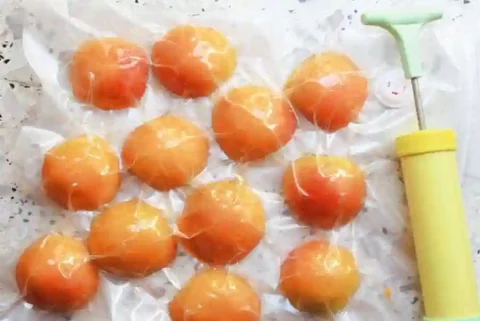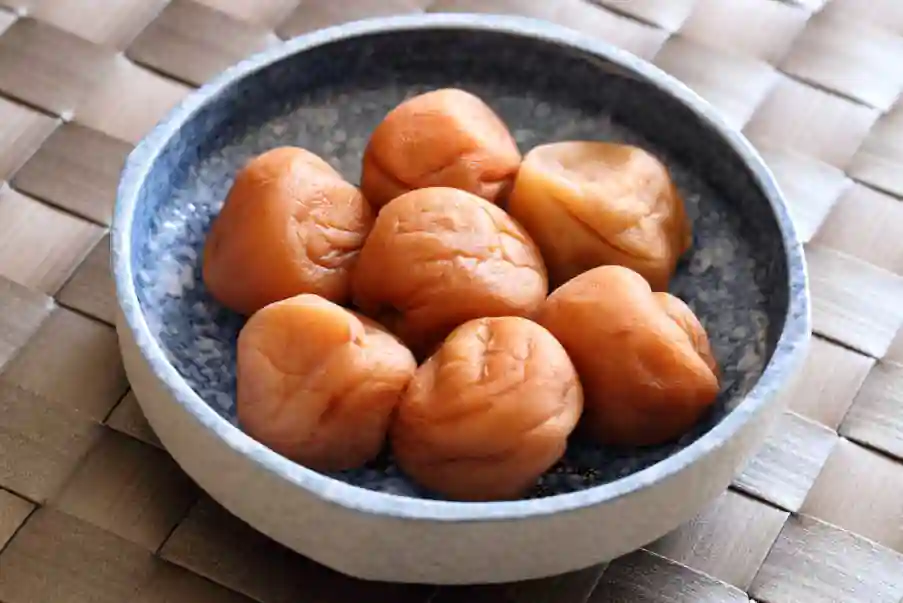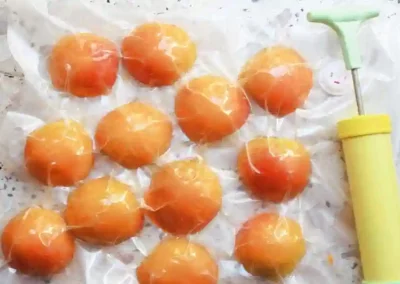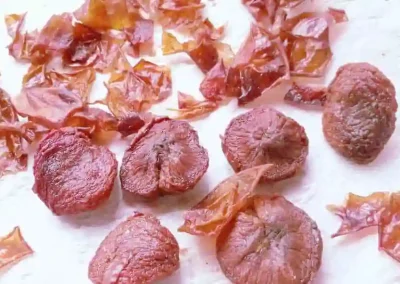Fermented Plums: Powerhouse Of Flavour And Nutrition
The art of fermenting plums and other fruits has captivated taste buds and nourished bodies from ancient times to the modern age. Packed with probiotics, vitamins, and antioxidants, and delivering a tangy – fruity hit, these lacto- fermented treats are a nutritional powerhouse with a unique flavour profile.
As well as enhancing flavour by releasing umami, the delicious fifth taste, the process of fermentation provides the body with health promoting bacteria to help increase the bioavailability of nutrients, making them easier to digest and absorb, as well as supporting digestive, immune and mental health
Whether enjoyed as a healthy snack or used as a condiment in recipes sweet and savoury, these tangy treats offer a burst of flavor to enhance any dish, tantalizing your taste buds while supporting your wellbeing
Science Of Fermentation
Fermentation is a natural process that occurs when microorganisms, such as bacteria or yeast, convert sugars into acids or alcohol. In the case of fermented plums, lactic acid producing bacteria are responsible for the transformation. These bacteria break down the sugars present in plums, releasing lactic acid and other compounds that give the fermented fruit its distinct tangy flavor and health-promoting properties
Lactic acid is a natural product resulting from the partial breakdown of sugars in the body. Lactic acid is an intermediate product in the process of energy production in the body, notably when there is insufficient oxygen to fully break down sugar, such as during high intensity, anaerobic exercise. It can be further broken down into carbon dioxide and water in the presence of oxygen to release more energy
The fermentation process not only alters the taste of plums but also enhances their nutritional profile
Lactic acid is a good source of food for your friendly gut bacteria. Moreover, these beneficial microorganisms present in fermented plums produce enzymes that break down complex nutrients into simpler forms, making them easier for the body to absorb. Fermentation increases the availability of many nutrients, including the vitamins A and C naturally present in the plums, contributing to your daily intake of these essential nutrients
The Process Of Lacto Fermentation
Lacto-fermentation is the natural process of selectively enhacing the growth of lacto-bacilli, the species of bacteria which turn sugars into lactic acid
Since most fruit and vegetables naturally contain lacto-bacteria, all you need to do is to provide the conditions for these to proliferate in preference to other potentially harmful bugs. Two simple conditions must be met:
- provide a 2-10% concentration of salt
- create an oxygen-free environment
Lacto-Bacteria Are Salt Resistant
While salt kills most bugs our friendly lacto-bacilli don’t mind a bit of salt, though they do mind a lot of it. The minimum salinity to suppress unwanted bacteria is 2% by weight. Although lactobacilli can technically function in an environment of anything up to 10% salinity, they fully thrive at between two and seven per cent salt concentration.
An environment higher than 10% in salt will suppress all microbial activity and lead to a curing process, a delicious way of preserving food outside the scope of this article
Lacto-Bacteria Are Anaerobic
Lactofermentation will only take place in anaerobic (no air) conditions. If your fruit or veg are directly exposed to oxygen they will soon develop mould and harmful bacteria which will spoil the whole batch
There are a few commonly-used methods for preventing air exposure
- Direct salting draws out water to create a brine in which you must keep your fruit fully immersed, usually with the help of a weight – sliced sauerkraut is usually made this way
- Or you can mix a brine in which to immerse your veg – this is the method used for fermented whole cabbages, the leaves of which are used to make the Turkish stuffed-cabbage dish Sarma. Preserved lemons are commonly also made this way
- Large pieces of fruit such as plums are rather more difficult to keep submerged and do very well fermented inside a vacum-seal bag. These are easily available and guarantee a scrupulously anaerobic environment.
- The vacuum-seal technique is the product of René Redzepi, head chef of the Michelin starred Noma restaurants. When fermenting plums this is, for me, the method of choice
Health Benefits of lacto-Fermentation
Fermented plums come with a wide range of health benefits. Lacto fermentation increases the bioavailability of nutrients, making them more easily absorbed by the body. In addition, lacto-fermented food is rich in probiotics, live heath-promoting bacteria essential for a healthy gut.
Science is becoming increasingly aware of the importance of healthy gut bacteria for your overall well-being. Aside from supporting digestive function the gut microbiome provides essential support to your nervous, immune and other regulatory systems. Variety of species is now understood to be a crucial factor, a microbiome rich in different microbial species being associated with concrete health benefits
By supporting the function of the nervous and immune systems, the gut microbiata helps your body fight infection and optimize essential processes including inflammation, appetite, mood, sleep and cognitive function
Antioxidants in fermented plums further help combat oxidative stress and inflammation, reducing the risk of chronic diseases.
The combination of health benefits and taste will make fermented plums a nutritious as well as delicious addition to your diet
How To Ferment Plums At Home
Making your own fermented plums at home is a rewarding and straightforward process. Apply the two golden rules of salt and no oxygen and you’re good to go
There are a few different methods, two of which I’ll share here. The first is brine fermentation in a glass jar or earthenware fermentation crock. This is the old fashioned method requiring no specialist equipment. The second is the “Noma” method, named after the Michelin starred restaurant’s head chef René Redzepi. This method uses halved and stoned plums with 2% salt in a vacuum-seal bag and produces a wonderful, though small quantity of plum vinegar. Make your choice, and let’s go
To start, you will need ripe plums, salt, and a clean, airtight container. Begin by washing the plums thoroughly and removing any stems or blemishes. Next, make a saltwater brine by dissolving salt in water. Place the plums in the container and pour the brine over them until they are fully submerged. Close the container tightly and let it sit at room temperature for several days to allow the fermentation process to take place. Once the plums reach the desired level of fermentation, transfer them to the refrigerator to slow down the fermentation process.
Lacto Plums 1: Brine Fermentation
Unless you want to end up with a plum paste or vinegar (both delicious, by the way) your plums won’t take kindly to being squashed together to exclude air. Japanese omeboshi “plums” (they’re apricots really) are entirely steeped in crystal salt (traditionally 20% by weight of fruit) to produce a product that’s rather more cured than fermented
One way to keep the salt content lower is to use brine.
1: Start by sterilizing your jar or crock and a second container where you’ll be mixing your brine
Wash the jar and lid / cover and any other utensils you’ll be using in soapy water. Rinse thoroughly and allow to dry naturally. Don’t use a cloth or even paper towel. Just leave them util they’re dry. You can speed up the process by placing the items on a sunny window-sill or in the oven set to the lowest temperature. Alternatively sterilize your equipment by wiping all surfaces with pure ethyl alcohol or vodka
2: Prepare the brine.
We’re going to make a 2-3% brine. The percentage is relative to the combined weight of the fruit and water. Here’s how I do it:
Weigh a large empty jar or fermentation crock. Fill the jar with washed plums and add enough water to cover the plums by about an inch (2.5cm). Subtract the weight of the empty jar from that of the full jar and you have the weight of the contents. Actually I have electronic scales which will parse or zero the weight. In this case, put the jar on the scales, zero, then proceed as above
Weigh out the salt to 2-3% of the combined weight of fruit and water
Pour the water out into a pan, heat till boiling then add the salt, mixing well to dissolve. Allow the brine to cool completely before returning to the crock
Keep the plums submerged with a fermentation weight. Alternatively fill a plastic sandwich bag with water or brine, tie it closed with a good strong knot and sit it on top of the plums
Close the container tightly and let it sit at room temperature for 7-8 days to allow the fermentation process to take place. Once you see bubbles forming you’ll need to take off the lid daily to “burp” out the resultant carbon dioxide. When the plums reach a level of fermentation agreeable to your palate, transfer them to the refrigerator to slow down the fermentation process and enjoy them within a month
Lacto Plums 2: Vacuum-Bag Method
This second, “Noma” method gives you complete control of the fermentation process. The recipe uses halved stoned plums which release a delectable sweet-salt-sour vinegar with a non end of uses. I’ve been tempted more than once to down the lot in a shot-glass before breakfast. Delicious!

- 1 kg plums washed, halved and stoned
- 20 g non iodized sea-salt
- use a fresh vacu-seal bag
- wash the plums under running water, cut in half and stone
- in a bowl toss the plums with the salt to cover evenly
- place in a vacuum seal bag, spaced apart by a couple of inches
- remove all the air with a pump
- leave in a warm place to ferment. Depending on the temperature, this will take anything from 5 days to over a week
- when the fermentation is underway the bag will fill with CO2 gas: burp the bag by opening, resealing and pumping out all the air once again
- from this point on, taste a small portion of the fruit until it reaches a balance of sweet-fuitiness and sourness to your taste
- recipes and ideas for using fresh and dried lacto plums and their skins follw
- At 25-28C this can take around 5 days. Fermentation at higher temperatures is quicker but gives a rather more acrid result. Generally, the slower the fermentation the better the taste
- As usual the degree of fermentation depends on your taste. I like them sharp but retaining some fruity sweetness. Let your tongue make the decision
- the plums and their vinegar will continue to ferment. To slow this down:
- store the fresh lacto-plums in their vinegar in the refrigerator for a month to 6 weeks
- or sun-dry for 3 days and store without the vinegar in a jar or plastic wrapper. They will stay good potentially indefinitely without refrigertion
- the vinegar can be stored seperately, preferably refrigerated
- the skins can be removed and sun or oven dried until crisp, then flaked or powdered to be added as a garnish to raw salads and cooked dishes
- recipes and ideas for using fresh and dried lacto-plums, as well the vinegar and skins follow later
Subscribe To Posts



